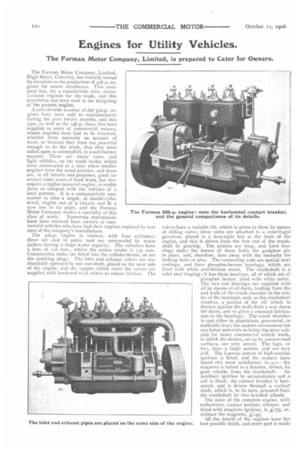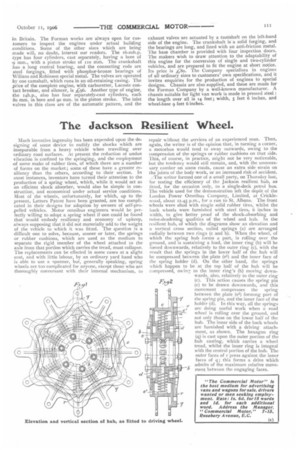Engines for Utility Vehicles.
Page 20

Page 21

If you've noticed an error in this article please click here to report it so we can fix it.
The Forman Motor Company, Limited, is prepared to Cater for Owners.
The Forman Motor Company, Limited, High Street, Coventry, has recently turned its attention to the production of 3oh.p. engines for motor omnibuses. This company has, for a considerable time, mannlactured engines for the trade, and this experience has been used in the designing of the present engine.
A considerable number of the 3oh.p. engines have been sold to manufacturers during the past twelve months, and this type, as well as the Lth.p. class, has been supplied to users of commercial motors, whose engines have had to be renewed, whether from necessity on account of wear, or because they were not powerful enough to du the work, that they were called upon to accomplish, in a satisfactory manner. There are many vans, and light vehicles, on the roads to-day which were constructed at a time when smaller engines were the usual practice, and these are, to all intents and purposes, good for several more years of hard work, but thev require a higher powered engine, to enable them to compete with the vehicles of a later pattern. It is a comparatively easy matter to take a single, or double-cylindere.d, engine out of a chassis and fit a new one in its place, and the Forman Motor Company makes a speciality of this
class of work. Numerous testimonials have been received from owners of commercial vehicles who have had their engines replaced by new ones of the company's manufacture.
The 3oh.p. engine is vertical, with four cylinders; these are cast in pairs, and are surrounded by water jackets having a large water capacity. The cylinders have a bore of i in mm., whilst the piston stroke is 130 mm. Compression cocks are fitted into the cylinder-heads, as are the sparking plugs. The inlet and exhaust valves are mechanically operated by one camshaft, placed on the near side of the engine, and the tappets which move the valves are supplied with hardened steel rollers to reduce friction. The
valves have a variable lift, which is given to them by means of sliding cams ; these cams are attached to a centrifugal' governor, placed in a dust-tight box at the front of the engine, and this is driven from the fore end of the crankshaft by gearing. The pistons are long, and have four rings each ; the lowest of these holds the gudgeon pin in place, and, therefore, does away with the necessity for locking bolts or pins. The connecting rods are special steel castings, and have phosphor-bronze bearings, which arelined with white anti-friction metal. The crankshaft is a solid steel forging ; it has three bearings, all of which are of phosphor bronze, lined with white metal. The two end bearings are supplied with oil by means of oil ducts, leading from the end walls of the crank chamber to the centre of the bearings, and, as the crankshaft revolves, a portion of the oil which is. thrown against the walls finds a way down the ducts, and so gives a constant lubrication to the bearings. The crank chamber is cast either in aluminium, gun-metal, or malleable iron ; the makers recommend the two latter materials as being the most suitable for heavy commercial vehicle work, in which the strains, set up by uneven road surfaces, are very severe. The lugs, or feet, have a large section, and are very. stiff. The Lacoste system of high-tension ignition is fitted, and the makers havefound this most satisfactory in te.:e : the magneto is bolted to a bracket, driven, by gear wheels, from the crankshaft. An auxiliary ignition by -accumulators and aeon is fitted: the contact breaker is horizontal, and is driven through a vertical' shaft, which is, in its turn, actuated from the crankshaft by two bevelled wheels. The price of the complete engine, with carburetter, contact breaker, silencer, and fitted with magneto ignition, is .175, or, without the magneto, L'145.
All the details of the engines have the' best possible finish, and every part is made in Britain. The Forman works are always open for customers to inspect the engines under actual building conditions. Some of the other sizes which are being .made will, no doubt, interest our readers. The 16-2oh.p. type has four cylinders, cast separately, having a bore of .9 mm., with a piston stroke of Ho mm. The crankshaft .has a long central bearing, and the connecting rods are steel forgings, fitted with phosphor-bronze bearings of Winans and Robinson special metal. The valves are operated by one camshaft, which runs in an oil-retaining casing. The price of the complete engine, with carburetter, Lacoste contact breaker, and silencer, is .‘96. Another type of engine, the 1411.p., also has four separately-cast cylinders, each So mm. in bore and 90 mm, in the piston stroke. The inlet valves in this class are of the automatic pattern, and the
exhaust valves are actuated by a camshaft on the left-hand side of the engine. The crankshaft is a solid forging, and the bearings are long, and lined with an anti-friction metal. The base chamber is provided with four inspection doors. The makers wish to draw attention to the adaptability of this engine for the conversion of single and two-cylinder vehicles, and are prepared to fit the engine at short notice. Its price is i;So. The Company specialises in engines of all ordinary sizes to customers' own specifications, and it invites enquiries for the production of engines to special designs. Chassis are also supplied, and these are made for the Forman Company by a well-known manufacturer. A chassis suitable for light van work is made in pressed steel : the length over all is 14 feet; width, 5 feet 6 inches, and wheel-base 9 feet 6 inches.






















